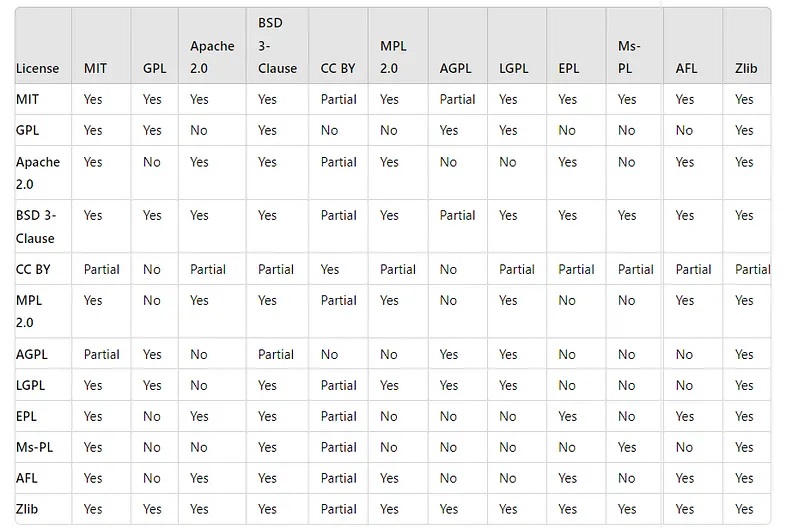This guide aims to prevent such mishaps by explaining the different types of software licenses, their specific terms, and the contexts in which they are best used.
Whether you’re developing open-source or proprietary software, understanding these licenses will help you protect your work and ensure it’s used in ways that align with your goals.
Table of Contents
- Importance of Software Licensing
- Key Terms and Concepts
- Licenses (12 Types Explained, when and when not to use, including real world case studies)
- License Comparison Table
- Choosing the Right License
- Common Pitfalls and Misunderstandings
- Dual Licensing
Importance of Software Licensing
Software licensing is more than just a legal necessity; it’s a crucial part of how software is shared and utilized. The right license can protect your intellectual property, dictate how others can use and modify your work, and even impact your revenue stream.Licenses are also vital for encouraging collaboration and innovation. Open-source licenses, for example, let developers build on each other’s work, accelerating progress and improving software quality. Proprietary licenses, on the other hand, safeguard your innovations and can generate income through licensing fees.
Understanding software licenses helps developers:
- Protect Intellectual Property: Ensure your software is used according to your terms and retain control over its distribution.
- Avoid Legal Issues: Comply with license terms to prevent legal disputes and protect your work.
- Encourage Collaboration: Choose licenses that support sharing and collective development, enhancing the software ecosystem.
- Enable Commercial Use: Opt for licenses that allow you to monetize your software through various business models.
Key Terms and Concepts
Open Source vs. Proprietary
- Open Source: Open source software is software with source code that anyone can inspect, modify, and enhance. Open source licenses allow software to be freely used, modified, and shared, creating a collaborative environment where developers from around the world can contribute.
Examples of open-source licenses include the MIT License, GNU General Public License (GPL), and Apache License 2.0. The significance of open source lies in its emphasis on transparency, community collaboration, and rapid innovation. - Proprietary: Proprietary software, on the other hand, is software that is owned by an individual or a company. The source code is usually not made available to the public, and users must typically purchase a license to use the software.
Modifications and redistribution are generally prohibited. Proprietary licenses protect the intellectual property and revenue streams of the software creators but limit user freedoms and collaboration.
Copyleft vs. Permissive
- Copyleft: Copyleft is a licensing philosophy that allows users to freely use, modify, and distribute software, provided that any derivative works are also distributed under the same license. This ensures that the software and any improvements remain free and open.
The GNU General Public License (GPL) is the most well-known example of a copyleft license. Copyleft licenses are significant because they guarantee that all future versions of a project will remain open-source, building an environment of continuous sharing and improvement. - Permissive: Permissive licenses are more flexible and place fewer restrictions on how the software can be used. They allow users to take the software and use it in proprietary projects without the requirement to open-source their derivative works.
Examples include the MIT License, BSD License, and Apache License 2.0. Permissive licenses are significant because they encourage broader use and adoption of software, including in commercial applications, thereby potentially reaching a larger audience.
Patent Rights
Patent rights in software licensing refer to the legal rights granted to inventors to exclude others from making, using, or selling their inventions for a certain period. In the context of software, patents can cover specific algorithms, methods, or techniques implemented by the software.- Why They Matter: Patent rights are crucial in software licensing because they can protect the intellectual property of the developers and ensure that their innovations are not used without permission.
Some licenses, like the Apache License 2.0, include explicit patent grants, allowing users to use the patented technology freely while using the software. This reduces the risk of patent litigation for users and promotes innovation by providing a clear legal framework for the use of patented technologies.
The Licenses
MIT License
When you need a permissive license that allows for easy reuse and modification.The MIT License is one of the simplest and most widely used open-source licenses. It allows users to do almost anything with your project, like making and distributing closed-source versions. The only requirement is to include the original copyright and license notice in any substantial portions of the software.
When to Use: Use it for projects where you want to maximize freedom for developers and allow commercial use.
When Not to Use: Avoid it if you want to ensure that all future versions of your project remain open-source.
- Example: jQuery
- Why Chosen: The MIT License is extremely permissive, allowing for broad use, modification, and distribution. jQuery’s developers wanted to ensure the library could be easily integrated into a wide range of projects, including commercial ones, without any licensing conflicts.
- Effect on Development and Distribution: The MIT License contributed to jQuery’s widespread adoption, as developers had the freedom to use and modify the library without worrying about restrictive terms. This led to jQuery becoming one of the most popular JavaScript libraries in the world.
GNU General Public License (GPL)
When you want to ensure that all modified versions of your project remain free and open-source.The GPL is a copyleft license, which means any derivative work must be distributed under the same license terms. It ensures that the software and any modifications to it remain free and open, preventing proprietary use.
When to Use: Use it for projects where you want to guarantee that all future developments and contributions stay open-source.
When Not to Use: Avoid it if you plan to integrate the project with proprietary software, as the copyleft requirement can be restrictive.
- Example: Linux Kernel
- Why Chosen: The GPL was chosen to ensure that Linux remains free and open-source. Any modifications or derivative works must also be open-source, protecting the software from becoming proprietary.
- Effect on Development and Distribution: The GPL has build a collaborative environment where developers contribute back to the kernel, leading to continuous improvements and innovations. It has also ensured that Linux remains free for everyone to use and modify.
Apache License 2.0
When you want to allow users to use the software for any purpose, but also want to protect your patent rights.The Apache License 2.0 is permissive like the MIT License, but with an added explicit grant of patent rights from contributors to users. It also includes a clause that allows for the redistribution of the software under different terms, making it flexible and protective.
When to Use: Use it for projects where you want a permissive license with patent protection and flexibility for both open and closed source usage.
When Not to Use: Avoid it if you want to enforce stricter open-source distribution requirements like the GPL.
- Example: Apache Hadoop
- Why Chosen: The Apache License 2.0 is permissive while also providing an explicit grant of patent rights, which reduces the risk of patent litigation. This makes it attractive for both open-source and commercial use.
- Effect on Development and Distribution: The license has encouraged a wide range of contributions from both individual developers and large corporations, helping Hadoop to evolve rapidly and become a cornerstone of big data processing.
BSD License (3-Clause)
When you need a permissive license with minimal restrictions and clear, simple conditions.The BSD 3-Clause License is a permissive license with minimal requirements about how the software can be redistributed. It allows proprietary use and does not require derivative works to be open-source.
When to Use: Use it for projects where you want to encourage use and modification with few restrictions.
When Not to Use: Avoid it if you want to ensure that all modified versions of your project remain open-source.
- Example: FreeBSD
- Why Chosen: The BSD License is permissive, with minimal restrictions on how the software can be used. It allows for proprietary use, making it attractive for commercial applications.
- Effect on Development and Distribution: The flexibility of the BSD License has led to FreeBSD being used as the foundation for many commercial operating systems, including Apple’s macOS. This has expanded its use and development far beyond the original project.
Creative Commons (CC BY)
When you want to share your work while allowing others to modify and distribute it, as long as they give you credit.The Creative Commons Attribution license allows others to use, distribute, and build upon your work, even commercially, as long as they credit you for the original creation. It is widely used for creative works like art, writing, and media.
When to Use: Use it for creative projects where you want to maximize distribution and modification with required attribution.
When Not to Use: Avoid it if you want to limit commercial use or modifications without your permission.
- Example: Wikipedia
- Why Chosen: The CC BY license allows for free use, distribution, and modification of content, as long as the original authors are credited. This aligns with Wikipedia’s goal of freely sharing knowledge.
- Effect on Development and Distribution: The license has enabled a vast community of contributors to freely add and edit content, making Wikipedia one of the most comprehensive and widely-used information sources in the world.
Mozilla Public License 2.0 (MPL 2.0)
When you want to allow the use of your code in proprietary projects, provided any modifications to your code itself are open-source.The MPL 2.0 is a middle-ground license that allows you to mix open-source and proprietary code. It requires that any modifications to your original files remain open-source, but it allows the larger project to be closed-source.
When to Use: Use it for projects where you want to protect your contributions but allow integration into proprietary software.
When Not to Use: Avoid it if you need a completely permissive license or one with strong copyleft requirements.
- Example: Mozilla Firefox
- Why Chosen: The MPL 2.0 allows Mozilla’s code to be used in both open-source and proprietary projects, provided that any changes to MPL-licensed files are shared. This balance was designed to encourage broad use while protecting core code contributions.
- Effect on Development and Distribution: The MPL has enabled Firefox to benefit from both community contributions and commercial support, helping it to remain a leading web browser while maintaining its open-source integrity.
AGPL (Affero General Public License)
When you want to ensure that all modifications, including those used over a network, remain open-source.The AGPL is similar to the GPL but with an additional requirement: any software that is used over a network must also be released under the same license. This ensures that software offered as a service (SaaS) remains open-source.
When to Use: Use it for web applications and networked software where you want to ensure all modifications are shared.
When Not to Use: Avoid it if you plan to develop software that will be integrated with proprietary services or if you find the network sharing requirement too restrictive.
- Example: MongoDB
- Why Chosen: The AGPL ensures that any networked use of the software also shares modifications, addressing the loophole in traditional GPL licenses where software could be used over a network without sharing changes.
- Effect on Development and Distribution: The AGPL has ensured that improvements made by users of MongoDB, especially in hosted services, are contributed back to the community, creating a collaborative ecosystem.
LGPL (Lesser General Public License)
When you want to allow linking to proprietary software while ensuring modifications to your library remain open-source.The LGPL is a more permissive variant of the GPL. It allows developers to link to (use) the LGPL-licensed library in their proprietary software without requiring the proprietary software to be open-sourced. However, any modifications to the LGPL-licensed components themselves must be released under the LGPL.
When to Use: Use it for libraries that you want to be freely used in both open-source and proprietary projects while keeping the library itself open-source.
When Not to Use: Avoid it if you want to enforce all users of your software, including linked proprietary applications, to be open-source.
- Example: GNU C Library (glibc)
- Why Chosen: The LGPL allows the library to be used by proprietary software while ensuring that modifications to the library itself remain open-source. This encourages wider use while protecting the core library.
- Effect on Development and Distribution: The LGPL has enabled glibc to become a fundamental part of many software systems, including commercial applications, without forcing them to open-source their entire codebase.
Eclipse Public License (EPL)
When you want to promote collaborative development while also allowing the combination with proprietary software.The EPL is similar to the MPL but with a stronger focus on contributions back to the community. It requires that any changes to the original code are open-sourced, but it allows combining with proprietary modules. The EPL also has a patent clause similar to the Apache License.
When to Use: Use it for software where you want to ensure changes are shared but allow broader integration with proprietary systems.
When Not to Use: Avoid it if you require all derivative works to be open-source under the same license.
- Example: Eclipse IDE
- Why Chosen: The EPL encourages contributions back to the original project while allowing integration with proprietary modules. This balanced approach promotes collaboration and commercial use.
- Effect on Development and Distribution: The EPL has facilitated a robust ecosystem around the Eclipse IDE, with contributions from both open-source developers and commercial entities, enhancing its features and adoption.
Microsoft Public License (Ms-PL)
When you want a permissive license with fewer restrictions than the GPL or MPL.The Ms-PL is a permissive open-source license from Microsoft. It allows for both commercial and non-commercial use, distribution, and modification of the software. However, it does not provide an express grant of patent rights.
When to Use: Use it for projects where you want to allow broad usage and modification with minimal restrictions.
When Not to Use: Avoid it if you need a license that explicitly grants patent rights.
- Example: Microsoft .NET
- Why Chosen: The Ms-PL is permissive, allowing for both commercial and non-commercial use, but does not provide an express grant of patent rights, which can be beneficial for commercial interests.
- Effect on Development and Distribution: The Ms-PL has enabled broad adoption of .NET by providing a clear and simple licensing model, buidling a large developer community and extensive library ecosystem.
Academic Free License (AFL)
When you want a permissive license with clear terms and an explicit grant of patent rights.The AFL is similar to the MIT and Apache licenses but with more precise language and explicit terms regarding the grant of patent rights. It aims to be legally sound and free from ambiguities.
When to Use: Use it for projects where you want to avoid any potential legal ambiguities and ensure clear permissions, including patent rights.
When Not to Use: Avoid it if you need a copyleft license or if the existing permissive licenses suffice for your project.
- Example: SAKAI
- Why Chosen: The AFL is permissive and legally precise, aimed at avoiding ambiguities in legal interpretation. It allows for broad use and modification while protecting the author’s rights.
- Effect on Development and Distribution: The AFL has facilitated collaboration among educational institutions and commercial entities, leading to the development of robust educational software platforms like SAKAI.
Zlib License
When you need a very simple and permissive license for your software.The Zlib License is a simple, permissive license that allows for free usage, modification, and distribution of the software. It requires acknowledgment in the software documentation but has no other significant restrictions.
When to Use: Use it for projects where simplicity and minimal restrictions are priorities.
When Not to Use: Avoid it if you require any form of copyleft or strict distribution terms.
- Example: Zlib Compression Library
- Why Chosen: The Zlib License is very simple and permissive, with minimal restrictions on how the software can be used. It’s designed for ease of use and integration.
- Effect on Development and Distribution: The simplicity and permissiveness of the Zlib License have led to its widespread adoption in many software projects, contributing to its reputation as a reliable and efficient compression library.
License Comparison Table
The following table shows the compatibility of the described license types with each other. This table indicates whether the licenses can be combined in a project. The compatibility is represented as “Yes” (compatible), “No” (not compatible), and “Partial” (compatible with conditions or limitations).
- Partial Compatibility: Indicates that the licenses can be combined under certain conditions, such as keeping the original license intact, attributing the original author, or adhering to specific restrictions (e.g., network use in AGPL, or ensuring modified files remain under the same license in MPL 2.0).
- No Compatibility: Indicates that the licenses have conflicting terms that prevent them from being combined in a single project without violating one or both licenses.
Choosing the Right License
Here are some practical guidelines and questions to help you make an informed decision.Guidelines for Selection
- Understand Your Goals: Determine what you want to achieve with your project. If your aim is widespread adoption, a permissive license like MIT or Apache 2.0 might be suitable. If you want to ensure that all derivatives remain open-source, consider a copyleft license like GPL.
- Consider Your Community: Think about who will be using and contributing to your software. Open-source communities often prefer licenses that encourage collaboration and sharing, while business-oriented users might favor licenses that allow for proprietary use.
- Legal Considerations: Be aware of the legal implications of the license you choose. Some licenses have specific requirements for distribution and modification that could impact how your software is used. Consulting with a legal expert can provide clarity on these issues.
- Compatibility with Other Software: Ensure that your chosen license is compatible with the licenses of other software you plan to use or integrate with. Some licenses have strict requirements that can limit compatibility.
- Future-Proofing: Consider how your choice of license will affect the project in the long term. Think about potential changes in the project’s direction and how different licenses might impact those changes.
Questions to Consider
- Do I want others to share their changes?: If you want all modifications and derivatives to be open-source, choose a copyleft license like GPL. If you’re okay with others keeping their changes proprietary, a permissive license like MIT or Apache 2.0 might be better.
- Is compatibility with proprietary software important?: If you need your software to be compatible with proprietary projects, avoid strong copyleft licenses like GPL and consider permissive licenses or MPL.
- Do I need to protect against patent claims?: If you’re concerned about patent litigation, consider licenses that include explicit patent grants, such as Apache 2.0.
- What level of restriction is acceptable?: Decide how much control you want over how others use your software. Permissive licenses offer more freedom but less control, while copyleft licenses enforce sharing and openness.
- How will the license affect contributions?: Think about how your license choice will influence contributions from the community. Some developers prefer permissive licenses for their flexibility, while others might be more inclined to contribute to projects with strong copyleft protections.
- What are the implications for commercial use?: If you plan to monetize your software, ensure that your license choice aligns with your business model. Some licenses allow for easy commercialization, while others may impose restrictions that could affect your revenue streams.
Common Pitfalls and Misunderstandings
Let’s clear up some of these misconceptions and highlight the potential legal risks of improper licensing.Misinterpretations
- Misunderstanding Copyleft Requirements: Many developers believe that copyleft licenses like the GPL require all software that uses the licensed code to be open-source. In reality, the GPL requires that any modified versions of the GPL-licensed code itself be open-sourced, not necessarily all code that interacts with it. This can still have broad implications, but it’s important to understand the specifics.
- Implications of Permissive Licenses: Permissive licenses such as the MIT or Apache License 2.0 are often misunderstood as completely free of restrictions. While they are indeed more flexible, they still require that the original license and copyright notice be included with any distributions. Ignoring this requirement can lead to legal issues.
- Public Domain Misconception: Some developers think that placing their software in the public domain means they can completely relinquish all rights and protections. However, the legal concept of public domain varies by jurisdiction, and in some places, it might not even be recognized. Using a well-defined permissive license is often a safer approach.
- License Compatibility Issues: Combining code with different licenses can lead to compatibility issues. For example, mixing GPL-licensed code with proprietary software can violate the GPL terms.
Legal Risks
- License Violations: Failing to comply with the terms of a software license can result in serious legal consequences. This includes not providing proper attribution, not sharing modifications as required by copyleft licenses, or using the software in ways prohibited by the license.
- Intellectual Property Disputes: Using or distributing software without a proper license can lead to intellectual property disputes. This can happen if you use code that you don’t have the rights to or if someone else uses your code without adhering to your license terms.
- Patent Infringement: Some licenses include clauses about patent rights. Ignoring these can lead to patent infringement claims. For instance, using software that includes patented technology without respecting the patent rights can result in legal action.
- Unintentional Open-Sourcing: Using a copyleft license without fully understanding its implications can lead to accidentally open-sourcing your proprietary code. This happens when modifications or integrations with copyleft code require you to release your own code under the same license.
- Enforcement Difficulties: If you don’t enforce your software license terms consistently, you risk weakening your legal position. This means regularly checking that users comply with the terms and taking action when they don’t.
Dual Licensing
Dual licensing is a strategy where a software project is released under two different licenses. Typically, one license is an open-source license that encourages community contributions and widespread use, while the other is a proprietary license that allows for commercial exploitation under specific terms.This approach gives users the flexibility to choose the license that best fits their needs, making the software accessible to both open-source enthusiasts and commercial enterprises.
When Dual Licensing Might Be Beneficial
- Balancing Open-Source and Commercial Interests: Dual licensing allows developers to serve both the open-source community and commercial clients.
For instance, the open-source license can boost a broad user base, attract contributions, and drive innovation, while the proprietary license can generate revenue by offering enhanced features, support, or integration capabilities to commercial users. - Encouraging Contributions While Monetizing Software: By offering the software under an open-source license, developers can attract contributions from a wide range of developers, benefiting from community-driven improvements and bug fixes.
At the same time, the proprietary license allows developers to monetize the software by charging for commercial use, thus sustaining the project financially. - Protecting Intellectual Property: Dual licensing can protect intellectual property by ensuring that commercial entities pay for the right to use the software in proprietary products.
This prevents commercial users from taking advantage of the software without contributing back or compensating the developers. - Expanding Market Reach: Dual licensing can help expand the market reach of the software. Open-source licenses attract individual developers, small startups, and educational institutions that prefer low-cost or free software.
Meanwhile, the proprietary license can cater to businesses that require commercial-grade support, warranties, and additional features. - Flexibility in Business Models: Dual licensing offers flexibility in how software developers can build their business models.
For example, a company might provide the core software under an open-source license and offer premium features, customizations, or services under a commercial license. This approach can attract a diverse user base while maintaining a viable revenue stream.
Examples of Dual Licensing
- MySQL: MySQL is a popular database management system that uses dual licensing. It is available under the GPL for open-source projects, while commercial licenses are available for enterprises that want to embed MySQL in proprietary applications without adhering to the GPL’s copyleft requirements.
- Qt: Qt is a cross-platform software development framework that offers both an open-source version under the GPL and a commercial license for businesses needing proprietary use, additional tools, and professional support.
When to Consider Dual Licensing
- You have a product that can attract both open-source contributions and commercial interest.
- You want to ensure that commercial entities contribute financially to the project.
- You need a sustainable revenue model while maintaining an open-source presence.
- You aim to protect your intellectual property from being used commercially without compensation.
Leave a comment
Leave a comment, an idea, a related blog post on X (Twitter)X (Twitter)

Early revenue is a liar. It tricks you into overspending, overhiring, and overestimating your success.
Learn why startups crumble in Year 2 — and how to stay alive.

What if the secret to scaling your startup isn’t about raising more funding, but unlocking the hidden goldmine already in your business? Uncover the hidden revenue streams hiding in plain sight.

Wonder how Trump’s takeover talk might unravel the Canal’s lucrative income stream? Brace yourself for potential ripples hitting everything from fuel prices to supermarket shelves

Steal like an entrepreneur (ethically)! Why reinvent the wheel when you can improve it? This approach saves you time, money, and countless headaches while keeping you ahead in the game.

Competing against businesses with larger budgets can feel like a David-and-Goliath battle. But the key to success isn’t about matching their spending — it’s about outthinking them.

Discover HEICO: The hidden aerospace jewel in Buffett's multi-billion-dollar portfolio!

